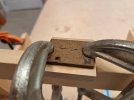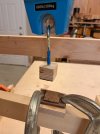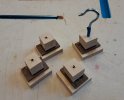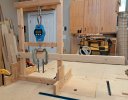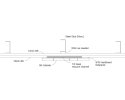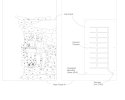In the intarsia wall project, I will be gluing a lot of 3/16 hardboard panels to either Baltic birch or to other layers of hardboard (which in turn will be glued to BB ply).
There are two distinctly different surfaces on hardboard - a rough and smooth surface.
In PMing with a very knowledgeable member of the forum, he concurred with me that no sanding of the smooth surface should be needed, but I wanted to be absolutely sure for a project of this magnitude.
A tensile stress tester was fashioned as shown. Four samples were prepared each having 1 square inch of glue surface. The adhesive was Titebond 3 cured for 24 hours at 73 degrees and 55% humidity. Clamping pressure for the samples is about what I expect to achieve on the project, about 6 psi.
The samples were: 1) rough to rough, 2) rough to smooth, 3) rough to sanded smooth and 4) sanded rough to smooth. The opposing sides were untreated glued to Baltic birch.
The samples were secured in the tester and slowly increasing pressure was applied to the lever arm.
All failures occurred at the hardboard to hardboard interface and appeared to be cohesive, not adhesive failure. However, I suspect that there to be an interplay at the bond layer, since no hardboard near Baltic failures occurred.
In any event the average failure was 143 psi, the lowest being rough to smooth sanded. While 4 samples is not enough to qualify as a full blown statistical analysis, I'm confident that the results meet my needs for the wall -- no sanding needed.
There are two distinctly different surfaces on hardboard - a rough and smooth surface.
In PMing with a very knowledgeable member of the forum, he concurred with me that no sanding of the smooth surface should be needed, but I wanted to be absolutely sure for a project of this magnitude.
A tensile stress tester was fashioned as shown. Four samples were prepared each having 1 square inch of glue surface. The adhesive was Titebond 3 cured for 24 hours at 73 degrees and 55% humidity. Clamping pressure for the samples is about what I expect to achieve on the project, about 6 psi.
The samples were: 1) rough to rough, 2) rough to smooth, 3) rough to sanded smooth and 4) sanded rough to smooth. The opposing sides were untreated glued to Baltic birch.
The samples were secured in the tester and slowly increasing pressure was applied to the lever arm.
All failures occurred at the hardboard to hardboard interface and appeared to be cohesive, not adhesive failure. However, I suspect that there to be an interplay at the bond layer, since no hardboard near Baltic failures occurred.
In any event the average failure was 143 psi, the lowest being rough to smooth sanded. While 4 samples is not enough to qualify as a full blown statistical analysis, I'm confident that the results meet my needs for the wall -- no sanding needed.

